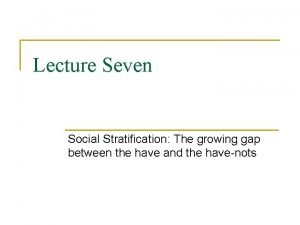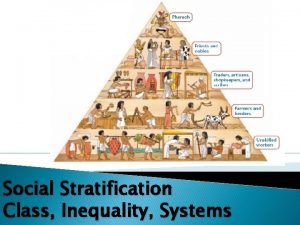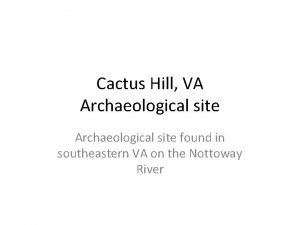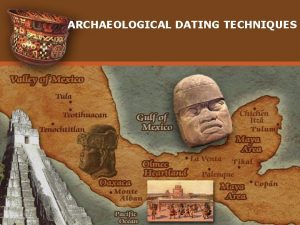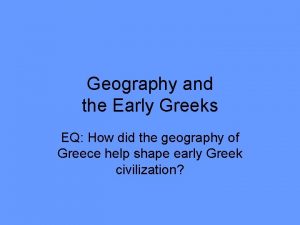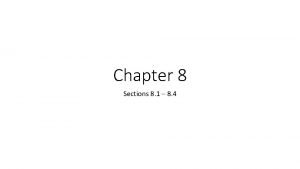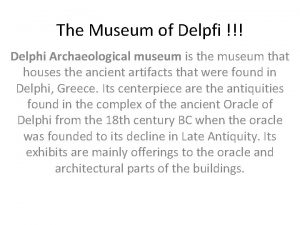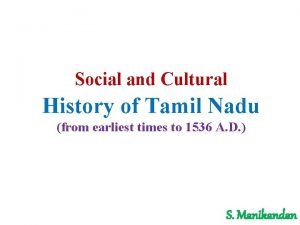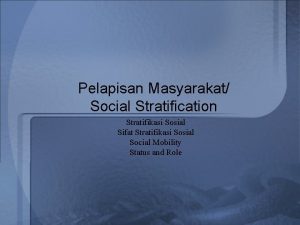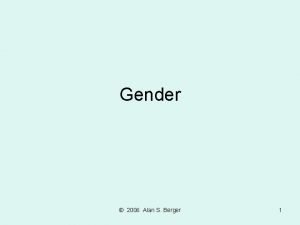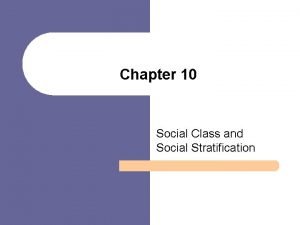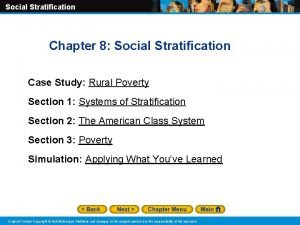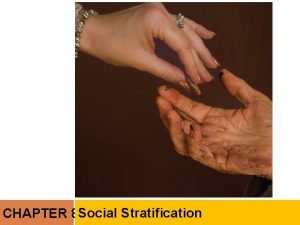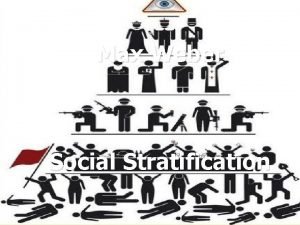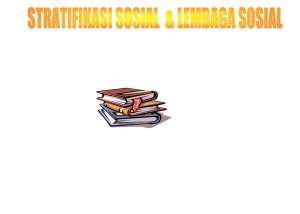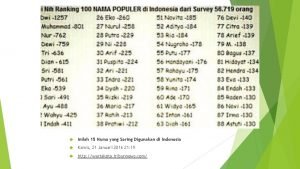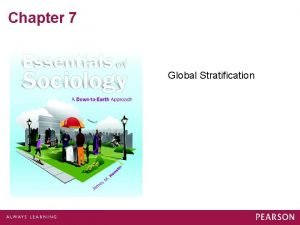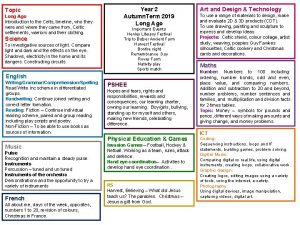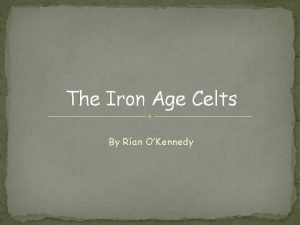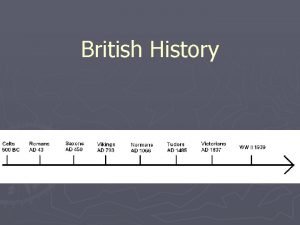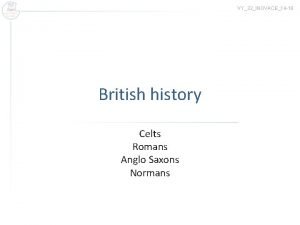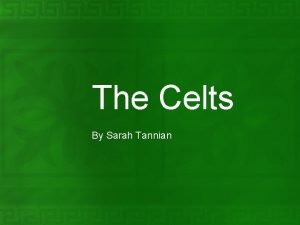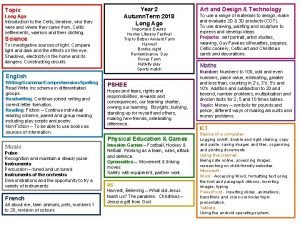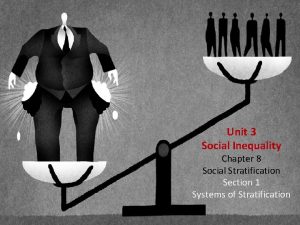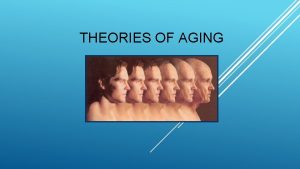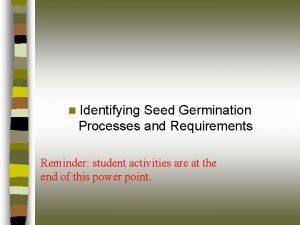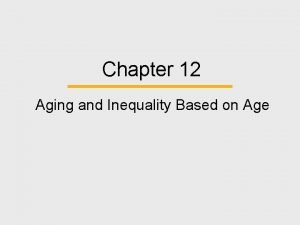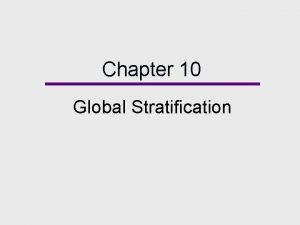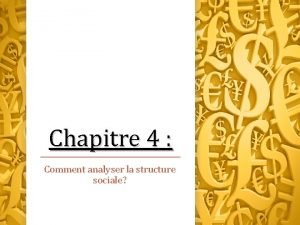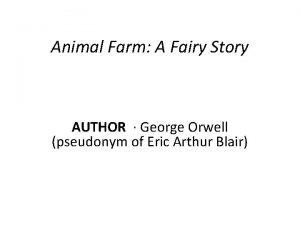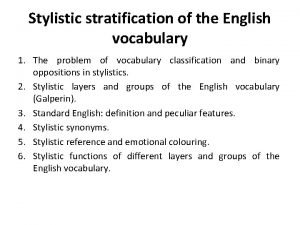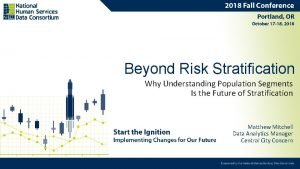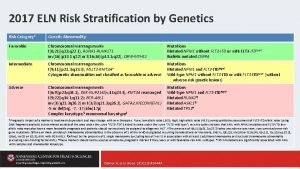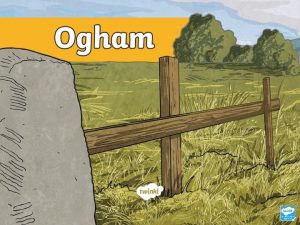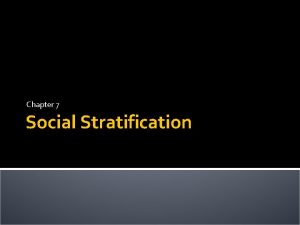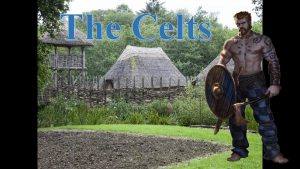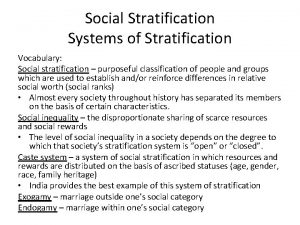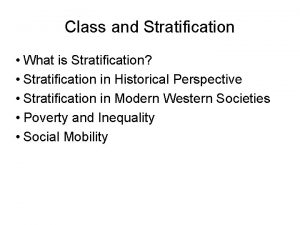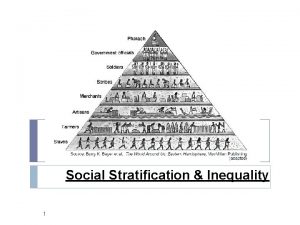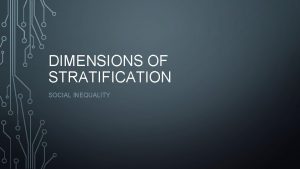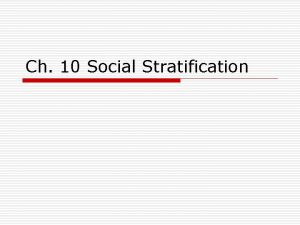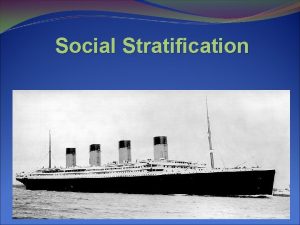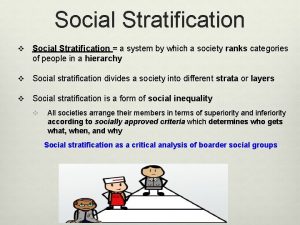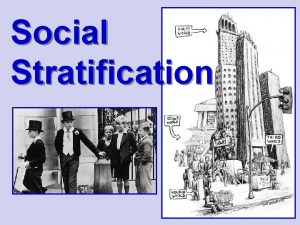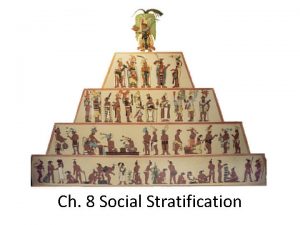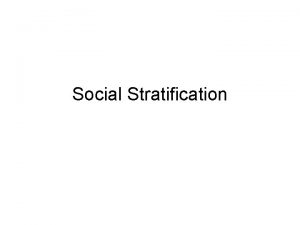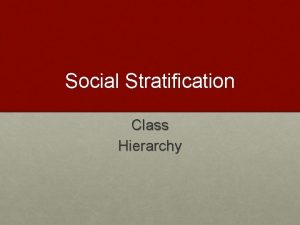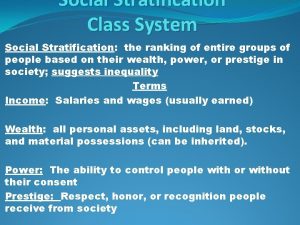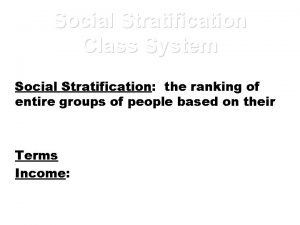CONTINENTAL CELTS ogham Continental Celts archaeological social stratification











![[The Gauls] cut off the heads of enemies slain in battle and attach them [The Gauls] cut off the heads of enemies slain in battle and attach them](https://slidetodoc.com/presentation_image_h2/75c1c25c9c3a3184edd4883418ea60ef/image-12.jpg)





![druids [The druids] judge all controversies, public and private; and also if any crime druids [The druids] judge all controversies, public and private; and also if any crime](https://slidetodoc.com/presentation_image_h2/75c1c25c9c3a3184edd4883418ea60ef/image-18.jpg)




































- Slides: 54

CONTINENTAL CELTS


ogham

Continental Celts archaeological • social stratification (warrior aristocracy) • loose tribal culture; lack of political centralization • absence of permanent shrines/altars • cult of warfare (fortifications, weapons) • ritual violence (head-hunting, human sacrifice) • local male deities • pan-tribal female deities 3 rd-party accounts • demonization • assimilation (interpretatio Romana) Irish myths • preserved by monks from 11 th century onward

Celtic Themes Religious Mythic animism theriomorphism transmigration head-hunting human sacrifice druidism triplism local (solar) male deities pan-tribal female deities cauldrons

animism : attribution of a life-force or “soul” to plants, inanimate objects, and natural phenomena; belief in a supernatural power that organizes and animates the material universe.

Celtic Themes Religious Mythic animism theriomorphism transmigration head-hunting human sacrifice druidism triplism local (solar) male deities pan-tribal female deities cauldrons

theriomorphism Cernunnos (“Horned One”)

Celtic Themes Religious Mythic animism theriomorphism transmigration head-hunting human sacrifice druidism triplism local (solar) male deities pan-tribal female deities cauldrons

Transmigration As one of their leading tenets they teach that souls do not become extinct, but pass after death from one body to another, and they think that men are excited to valor by this belief, the fear of death being disregarded. Caesar, de Bello Gallico 14 They do not fear death, but subscribe to the doctrine. . . that the human spirit is immortal and will enter a new body after a fixed number of years. For this reason some will throw letters to their relatives on funeral pyres, believing that the dead will be able to read them. Diodorus Siculus, Biblioteca Historica 28

Celtic Themes Religious Mythic animism theriomorphism transmigration head-hunting human sacrifice druidism triplism local (solar) male deities pan-tribal female deities cauldrons
![The Gauls cut off the heads of enemies slain in battle and attach them [The Gauls] cut off the heads of enemies slain in battle and attach them](https://slidetodoc.com/presentation_image_h2/75c1c25c9c3a3184edd4883418ea60ef/image-12.jpg)
[The Gauls] cut off the heads of enemies slain in battle and attach them to the necks of their horses. The blood-stained spoils they hand over to their attendants and carry off as booty, while striking up a paean and singing a song of victory, and they nail up these first fruits upon their houses just as those who lay low wild animals in certain kinds of hunting. They embalm in cedar oil the heads of the most distinguished enemies and preserve them carefully in a chest, and display them with pride to strangers. . . —Diodorus Siculus, Biblioteca Historica 29

head-hunting

Celtic Themes Religious Mythic animism theriomorphism transmigration head-hunting human sacrifice druidism triplism local (solar) male deities pan-tribal female deities cauldrons

human sacrifice

human sacrifice

Celtic Themes Religious Mythic animism theriomorphism transmigration head-hunting human sacrifice druidism triplism local (solar) male deities pan-tribal female deities cauldrons
![druids The druids judge all controversies public and private and also if any crime druids [The druids] judge all controversies, public and private; and also if any crime](https://slidetodoc.com/presentation_image_h2/75c1c25c9c3a3184edd4883418ea60ef/image-18.jpg)
druids [The druids] judge all controversies, public and private; and also if any crime has been perpetrated, if murder has been committed, if there is any dispute about an inheritance or boundaries… They assemble at a fixed period of the year in … the central region of the whole of Gaul. All who have disputes assemble from every part, and submit to their decrees and determinations. —Caesar, De Bello Gallico 14

druids The druids do not go to war, nor pay tribute together with the rest. They are said to learn by heart a great number of verses; accordingly some remain in the course of druid training twenty years… As one of their leading tenets they teach that souls do not become extinct, but pass after death from one body to another, and they think that men are excited to valor by this belief, the fear of death being disregarded. They likewise discuss many things about the stars and their motion, the extent of the world and of our earth, the nature of things, and the power and the majesty of the immortal gods. —Caesar, De Bello Gallico 14

druids • Old Irish druí (Lat. druides) < *dru (oak) + *wids (see) • high position in Celtic society • tasked with maintenance of oral tradition: religious rites, divination, law, poetry, education • belief in natural magic, reincarnation, transmigration

Celtic Themes Religious Mythic animism theriomorphism transmigration head-hunting human sacrifice druidism triplism local (solar) male deities pan-tribal female deities cauldrons

triplism

triplism

triplism Matrones (“Mothers”)

Celtic Themes Religious Mythic animism theriomorphism transmigration head-hunting human sacrifice druidism triplism local (solar) male deities pan-tribal female deities cauldrons

male solar deity

Urnfield Culture (Trundholm Chariot, ca. 1300 BCE)

Continental Celtic Male Deities Teutates “God of Folk” drowning Taranis “Thunderer” immolation Esus “Master” hanging

Gundestrop Cauldron (100 BCE – 100 CE)

Continental Celtic Male Deities Teutates “God of Folk” drowning Taranis “Thunderer” immolation Esus “Master” hanging

The nation of all the Gauls is extremely devoted to superstitious rites; and on that account they who are troubled with unusually severe diseases, and they who are engaged in battles and dangers, either sacrifice men as victims, or vow that they will sacrifice them, and employ the druids as the performers of those sacrifices; because they think that unless the life of a man be offered for the life of a man, the mind of the immortal gods can not be rendered propitious, and they have sacrifices of that kind ordained for national purposes. Others have figures of vast size. . . which they fill with living men, which being set on fire, the men perish enveloped in the flames. Caesar, de Bello Gallico 16

Continental Celtic Male Deities Teutates “God of Folk” drowning Taranis “Thunderer” immolation Esus “Master” hanging

Sucellus (“Good Striker”)

Giant of Cerne Abbas (Dorset, UK ca. 100 BCE)

Belenus (“Bright”? )

Cernunnos (“Horned One”)

Cernunnos (“Horned One”)

Lugus

Celtic Themes Religious Mythic animism theriomorphism shamanism transmigration head-hunting human sacrifice druidism triplism local (solar) male deities pan-tribal female deities cauldrons

Matronae (“Mothers”)

Rosmerta

Epona (“Horse Rider”)

Celtic Themes Religious Mythic animism theriomorphism shamanism transmigration head-hunting human sacrifice druidism triplism local (solar) male deities pan-tribal female deities cauldrons

cauldron

Gundestrop Cauldron (2 nd cent. BCE)

Continental Celts archaeological • social stratification (warrior aristocracy) • loose tribal culture; lack of political centralization • absence of permanent shrines/altars • cult of warfare (fortifications, weapons) • ritual violence (head-hunting, human sacrifice) • local male deities • pan-tribal female deities 3 rd-party accounts • demonization • assimilation (interpretatio Romana) Irish myths • preserved by monks from 11 th century onward

Romano-Celtic Period (100 BCE – 250 CE) 60 s BCE Roman campaigns in Europe and Britain by J. Caesar 60 CE Britain a Roman province 122 CE Hadrian’s Wall constructed to impede Scots Gaelic tribes

The men came on an ancient and sacred grove. Its interlacing branches enclosed a cool central space into which the sun never shone, but where an abundance of water spouted from dark springs…The barbaric gods worshipped here had their altars heaped with hideous offerings, and every tree was sprinkled with human blood. The images were stark, gloomy blocks of unworked timber, rotten with age, whose ghastly pallor terrified their devotees — quite another matter from our own rustic statues which are too familiar to cause alarm. Superstitious natives believed that the ground often shook, that groans rose from hidden caverns below, that yews were uprooted and miraculously replanted, and that sometimes serpents coiled about the oaks, which blazed with fire but did not burn. —Lucan, Pharsalia

On the shore stood the opposing army with its dense array of armed warriors, while between the ranks dashed women, in black attire like the Furies, with hair disheveled, waving brands. All around, the druids, lifting up their hands to heaven, and pouring forth dreadful curses, scared our soldiers by the unfamiliar sight… Then urged by their general's appeals [the Romans] struck down all resistance … A force was next set over the conquered, and their groves, devoted to inhuman superstitions, were destroyed. They [the Celts] deemed it indeed a duty to cover their altars with the blood of captives and to consult their deities through human entrails. —Tacitus XIV. 30

interpretatio Romana They worship Mercury in particular, and regard him as the inventor of all arts. They consider him the guide of their journeys, and believe him to have great influence over business transactions. After him they worship Apollo, and Mars, and Jupiter, and Minerva; with regard to these deities they have for the most part the same belief as other nations: that Apollo averts diseases, that Minerva teaches the invention of implements, that Jupiter has sovereignty over the heavenly powers; that Mars presides over wars. —Caesar, De Bello Gallico 17

Mercury & Rosmerta

Mercury ~ Lugus ROMAN CONTINENTAL Mercurius Omnium Artium (Mercury of All Crafts) Lugus

Continental Celts archaeological • social stratification (warrior aristocracy) • loose tribal culture; lack of political centralization • absence of permanent shrines/altars • cult of warfare (fortifications, weapons) • ritual violence (head-hunting, human sacrifice) • local male deities • pan-tribal female deities 3 rd-party accounts • demonization • assimilation (interpretatio Romana) Irish myths • preserved by monks from 11 th century onward

Lebhor Gabala Erenn (Book of Leinster, 11 th century CE) Old Irish is the oldest written European vernacular, preserving the largest volume of texts in any European language.
 Social stratification vs social inequality
Social stratification vs social inequality Social hiearchy
Social hiearchy On which waterway is cactus hill located?
On which waterway is cactus hill located? Mortimer wheelar used scientific and soil layer method
Mortimer wheelar used scientific and soil layer method Archaeological site of mycenae
Archaeological site of mycenae An archaeological dig turns up large numbers
An archaeological dig turns up large numbers Archaeological resources protection act of 1979
Archaeological resources protection act of 1979 Delpfi
Delpfi Gulf of mannar
Gulf of mannar Site:slidetodoc.com
Site:slidetodoc.com Convergent continental boundary
Convergent continental boundary Mixed social stratification
Mixed social stratification Gender and social stratification
Gender and social stratification Social stratification slideshare
Social stratification slideshare Weber class
Weber class Social inequality examples
Social inequality examples Chapter 8 social stratification
Chapter 8 social stratification Dimensions of stratification
Dimensions of stratification Max weber social stratification
Max weber social stratification Marx social stratification
Marx social stratification Systems of social stratification
Systems of social stratification Social stratification in sociology
Social stratification in sociology Jelaskan pengertian
Jelaskan pengertian Mixed social stratification
Mixed social stratification Chapter 9 social stratification
Chapter 9 social stratification Causes of social mobility
Causes of social mobility Weber status
Weber status Global stratification systems
Global stratification systems The celts timeline
The celts timeline Where did the celts come from
Where did the celts come from The celts timeline
The celts timeline Language
Language Celts romans anglo saxons vikings normans
Celts romans anglo saxons vikings normans Where were the celts from
Where were the celts from Celts timeline
Celts timeline Social thinking social influence social relations
Social thinking social influence social relations Social thinking social influence social relations
Social thinking social influence social relations Open and closed stratification systems
Open and closed stratification systems Continuity theory
Continuity theory Global stratification definition
Global stratification definition Global stratification definition
Global stratification definition Stratification sociale
Stratification sociale Germination process drawing
Germination process drawing Age stratification
Age stratification Global stratification definition
Global stratification definition Stratification sociale
Stratification sociale Scarification and stratification of seed
Scarification and stratification of seed Aacvpr risk stratification
Aacvpr risk stratification The societal tendency toward class stratification
The societal tendency toward class stratification The societal tendency toward class stratification
The societal tendency toward class stratification Stylistic stratification
Stylistic stratification Risk stratification
Risk stratification Risk stratification pyramid
Risk stratification pyramid Eln risk
Eln risk Eutrophic lake
Eutrophic lake
